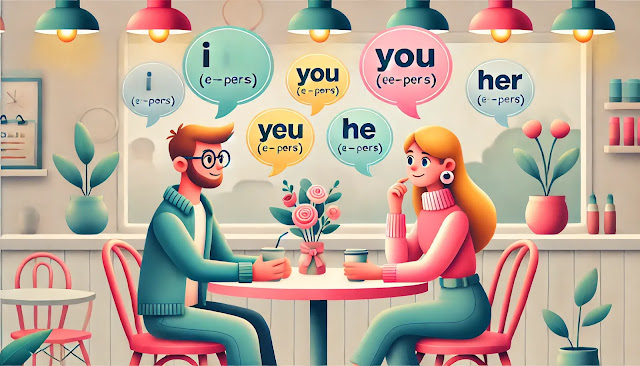| Anna | Ben |
|---|---|
| Hi, Ben! How are you? | Hi, Anna! I’m good. How about you? |
| I’m fine, thanks. Did you see Tom today? | Yes, I saw him this morning. He was at the park with his dog. |
| Oh, that’s nice. I haven’t talked to him in a while. How is he? | He’s doing well. He said he’d call you later. |
| Great! By the way, is this your backpack? | No, it’s not mine. Maybe it’s hers. Ask Lisa. |
| Lisa? I saw her earlier, but she didn’t have a backpack with her. | Hmm, then it could be theirs. John and Mary were here earlier. |
| I’ll ask them. Thanks, Ben. | You’re welcome! Let me know if you need help. |
| Sure, I will. See you later! | Bye! |
Pronouns are an important part of English grammar. They make sentences shorter and easier to understand. Learning how to use pronouns correctly is essential for improving your English skills.
What are pronouns?
Pronouns are words that replace nouns in a sentence. Instead of repeating the same noun many times, you can use a pronoun. For example:
- Maria is a teacher. She loves teaching.
In this sentence, "she" is a pronoun that replaces "Maria."
Types of pronouns
There are different types of pronouns in English. Let’s look at the most common ones:
1. Subject pronouns
These pronouns act as the subject of a sentence. Examples:
I
You
He
She
It
We
They
Examples in sentences:
I am learning English.
They are going to the park.
2. Object pronouns
These pronouns receive the action in a sentence. Examples:
Me
You
Him
Her
It
Us
Them
Examples in sentences:
Can you help me?
She gave the book to him.
3. Possessive pronouns
These pronouns show ownership. Examples:
Mine
Yours
His
Hers
Its
Ours
Theirs
Examples in sentences:
This book is mine.
That house is theirs.
4. Reflexive pronouns
These pronouns refer back to the subject of the sentence. Examples:
Myself
Yourself
Himself
Herself
Itself
Ourselves
Yourselves
Themselves
Examples in sentences:
I made this cake myself.
They cleaned the room themselves.
5. Demonstrative pronouns
These pronouns point to specific things. Examples:
This
That
These
Those
Examples in sentences:
This is my favorite song.
Those are her shoes.
6. Interrogative pronouns
These pronouns are used to ask questions. Examples:
Who
Whom
Whose
What
Which
Examples in sentences:
Who is coming to the party?
Which is your bag?
Tips for using pronouns
- Make sure the pronoun matches the noun it replaces in gender (he/she/it) and number (singular/plural).
- Always use the correct type of pronoun for the role it plays in the sentence (subject, object, etc.).
- Avoid unnecessary repetition of nouns by using pronouns where appropriate.
Pronouns vs. Nouns: A simple comparison
- Pronouns are words used to replace nouns. They help avoid repetition and make sentences smoother. For example, instead of saying "Anna is reading a book. Anna likes the book," we use "Anna is reading a book. She likes it."
- Nouns are the names of people, places, things, or ideas. They give specific information about what or who we are talking about. For example, "Anna," "book," and "park" are all nouns.
Key Differences:
- Function: Nouns name something, while pronouns replace those names.
- Clarity: Nouns provide specific details; pronouns rely on context for meaning.
- Example:
Noun: "The cat is sleeping."
Pronoun: "It is sleeping."
By practicing with pronouns, you can make your English sound more natural and fluent. Keep learning and practicing, and you will see improvement!

Comments
Post a Comment